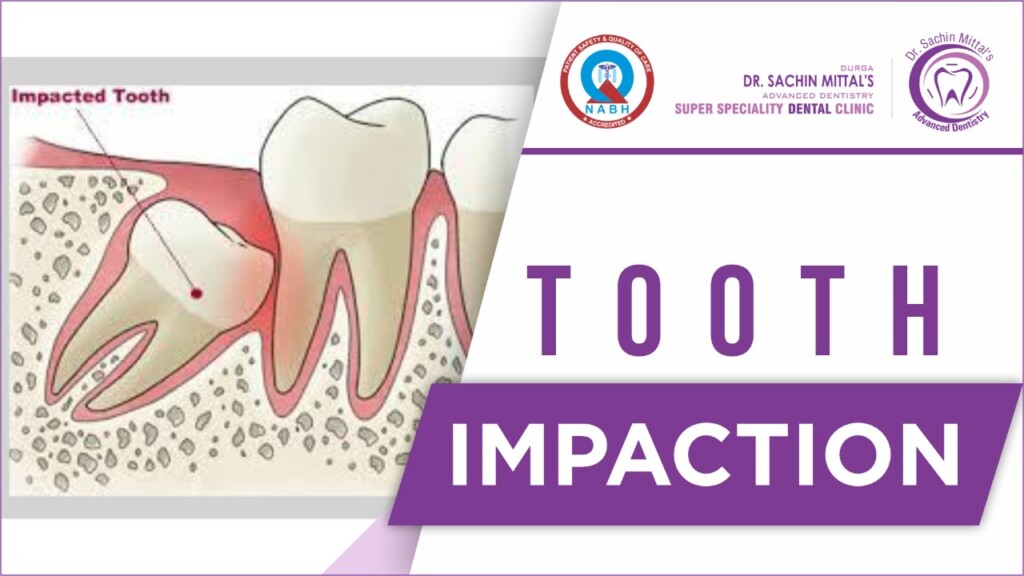What is an Impacted Tooth?
Primary (baby) teeth erupt through the gums during childhood. Around the age of six, these teeth begin to fall out and adult teeth begin to emerge.
Permanent teeth can erupt unnaturally in some circumstances, causing issues later on. An impacted tooth, for example, is one that does not fully emerge or emerges just partially.
To prevent dental crowding and other problems, an impacted tooth must usually be surgically removed or exposed.

Causes of a Missing Tooth
Overcrowding in the dental arch is the most common cause of an impacted tooth. Because there isn’t enough room in your jaw, your teeth may grow crooked and overlap.
An impacted tooth can also be caused by the following factors:
- Dental Trauma – a traumatic dental injury might cause a tooth to erupt later than expected, resulting in an impacted tooth. The upper jaw’s incisors are the most typically affected.
- Baby teeth that loosen but then tighten back into the gums, inhibiting the eruption of permanent teeth, are known as over-retained baby teeth. These teeth are usually extracted by dentists and oral surgeons to allow for the appropriate eruption of permanent teeth. Dental crowding, which can lead to impacted teeth, is prevalent if they are not removed.
- This is especially frequent in wisdom teeth (third molars).
- People with extra teeth are known as people with supernumerary teeth. Extra teeth can cause maxillary incisors to become impacted (the front teeth in the upper jaw).
Which Teeth Are Most Frequently Affected?
The wisdom teeth (third molars) and canines in the upper jaw are most typically affected by impaction (maxillary canines).
Wisdom teeth
Wisdom teeth, also known as third molars, emerge five to nine years after the 12-year molars (second molars).
Because wisdom teeth do not grow properly, most people have them removed between the ages of 16 and 20. Because jawbones are rarely broad enough for third molars to emerge correctly, they can grow at various angles, including horizontally.
You’re more prone to have impacted wisdom teeth if you have a narrow jaw. If an impacted wisdom tooth is not removed, serious dental infections and cysts can develop.
Canines of the Maxilla (Upper Jaw)
The canines in the upper jaw are the second most often impacted teeth. These teeth are necessary because they aid in the ripping and tearing of food. Dentists rarely extract them as a result of this. Instead, they apply treatments that aid with normal erupting.
Symptoms of a Tooth that Has Been Impacted
A lot of the time, impacted teeth don’t show any signs or symptoms. The longer a tooth is impacted, the more likely it is to develop the following symptoms:
- Even after brushing your teeth, you have bad breath (halitosis).
- The mouth has a bad flavor (typically near the tooth).
- Gums that are painful, red, and swollen.
- Opening the mouth is difficult.
- When opening or closing the jaw, there is pain.
- Headaches that come on unexpectedly and last for a long time.
- Lymph nodes in the neck can enlarge on occasion.
- Space between teeth from which a tooth should arise.
Impacted Teeth Complications
If your dentist removes an impacted tooth, serious consequences are unlikely. Serious dental infections, prolonged oral irritation, plaque buildup, and nerve damage are all possible if it isn’t eliminated. Other issues that could arise include:
Abscess of the tooth
A tooth abscess develops as a result of a bacterial infection caused by a buildup of pus inside the gums and teeth over time. An abscess is often accompanied by throbbing and pain near the damaged tooth.
Malocclusion (Teeth Misalignment)
The misalignment of teeth is referred to as malocclusion. Misalignment, such as dental crowding, can be caused by impacted teeth, teeth lost early, and excess teeth.
Scaled crossbite malocclusion
Periodontitis, often known as gingivitis, is a type of gum disease that affects the teeth. Gingivitis is a moderate form of gum disease that produces inflammation of the gingival tissues but does not result in bone loss. This type of gum disease can be treated during professional dental cleanings and is reversible. Periodontal disease, a nonreversible gum disease that causes lifelong bone loss, can develop if it is not treated.
Impacted Teeth Treatment Options
If an impacted tooth is not creating issues, treatment may not be required. Although, in most situations, impacted wisdom teeth should be removed by the age of 20 if they are not growing properly.
If the impacted tooth is in the front of your mouth, orthodontic therapy may be beneficial. Braces, for example, might aid in the right positioning of the teeth. A surgical procedure will be required to expose an impacted back tooth. There are two kinds of oral surgery that are used to reveal impacted teeth:
Eruption in the Open
Your dentist or oral surgeon will surgically uncover the crown of the impacted tooth behind the gums during an open eruption treatment. The tooth is exposed to the oral cavity and is bordered by palate or labial mucosa soft tissue (inside lining of the lips). Following exposure, the dentist may see the tooth directly, allowing for optimal eruption.
Closed Eruption
Your dentist or orthodontist will surgically expose the tooth beneath the gums during a closed eruption treatment. The overlying mucosa will then be replaced and an orthodontic attachment will be placed.
Finally, a chain extends through the mucosa from the connection, allowing the dentist to apply traction to the tooth and replicate normal tooth eruption. This is a lengthy treatment, but it may be required for impacted incisors and other front teeth.

